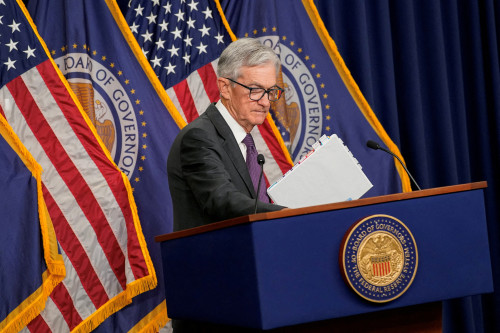By Howard Schneider
WASHINGTON (Reuters) -U.S. Federal Reserve officials feel they need to reconsider the key elements around both jobs and inflation in their current approach to monetary policy, given the inflation experience of the last few years and the possibility that supply shocks and the associated price increases may become more frequent in the years ahead, Fed chair Jerome Powell said Thursday.
“We may be entering a period of more frequent, and potentially more persistent, supply shocks—a difficult challenge for the economy and for central banks,” Powell said in opening remarks at a two-day conference reconsidering the Fed’s current approach to monetary policy, adopted in 2020 as the economy was still scarred by the pandemic.
“The economic environment has changed significantly since 2020, and our review will reflect our assessment of those changes,” Powell said.
Powell did not focus on current monetary policy or the economic outlook. He did say he expected April personal consumption expenditures price inflation to have fallen to 2.2% — a tepid reading but still likely not reflecting coming tariff-driven price increases.
Still that reflects a “historically unusual result” of inflation falling from its pandemic peak without major damage to the economy, a “soft landing” that did take place under the Fed’s current strategy. The current unemployment rate of 4.2% is higher than a year ago but remains around the level considered full employment by Fed officials.
But his comments suggest the Fed may be moving toward a strategic approach that makes more explicit its plans to stay in front of potential inflation shocks in the future — something former officials and analysts have called for given the central bank’s slow response when inflation surged in 2021.
Caution around inflation is one reason the Fed has been cautious about drawing quick conclusions about the impact of the Trump administration’s tariff policies, which have clouded their ability to judge the economy’s strength and direction, and officials are also still wrestling over how the U.S. and global economies changed as a result of the pandemic.
The trend towards increasing globalization and market integration which helped anchor low inflation up to the pandemic, for example, may be running in reverse as companies design more flexible supply chains and, now, respond to a developing tariff war.
The Fed for now has said it would stay on the sidelines, with interest rates held steady in the current 4.25% to 4.5% range until those questions get resolved.
At the same time, policymakers have since the start of the year been debating how to change their overarching approach to monetary policy, contained in a document that establishes things like the 2% inflation target and discusses how to achieve that and its other mandate of maximum employment.
Five years ago the Fed recast its approach to allow more room for lower unemployment rates and pledged to use periods of high inflation to offset years in which inflation was weak, a common occurrence from 2010 to 2019.
The inflation that took off after that, and the emerging state of the global economy, means that approach may need a rethink, Powell said.
“In our discussions so far, participants have indicated that they thought it would be appropriate to reconsider the language around shortfalls” of employment, a change adopted so the Fed would not consider a low unemployment rate in itself a sign of inflation risk, Powell said.
“At our meeting last week, we had a similar take on average inflation targeting. We will ensure that our new consensus statement is robust to a wide range of economic environments and developments.”
His comments point to possibly extensive revisions to a strategy that had been viewed at its inception as a major shift for the Fed, with a willingness to take more risks in favor of a stronger job market and a willingness to tolerate higher inflation after periods of weakness.
But “the idea of an intentional, moderate overshoot proved irrelevant to our policy discussions and has remained so through today” following the near double-digit inflation that occurred during the pandemic reopening, Powell said.
Powell said amendments to the strategy will likely be made “in coming months.” The last framework was unveiled at the Kansas City Fed’s annual August research conference in Wyoming.
(Reporting by Howard Schneider; Editing by Anna Driver and Chizu Nomiyama)





